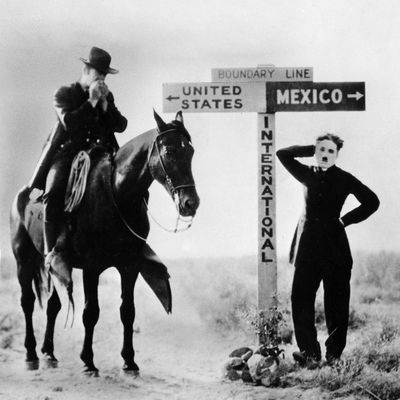
It’s been a very long time since we had a wave of culture released to the public domain. For years, the rule was that art became free to everyone to view or use for educational purposes after 75 years in release (given their copyrights had been renewed at certain points). However, Congress changed things in 1998, issuing a 20-year hold on copyright-renewed items entering the public sphere.
Well, those 20 years are up! This means Kangaroo by D.H. Lawrence, The Prophet by Kahlil Gibran, and Tarzan and the Golden Lion by Edgar Rice Burroughs are now part of the public domain, and you can listen to “Yes! We Have No Bananas” and “The Charleston” while you read them. What does this mean for movie lovers? A number of great, important films — all from 1923 — are now available for you to view. Here are 12 of the most exciting ones, in alphabetical order.
The Barnyard
There’s a drama working its way through the art-house scene right now starring John C. Reilly and Steve Coogan called Stan & Ollie about the legendary comedy duo of Stan Laurel and Oliver Hardy. The latter stars in this Larry Semon flick, billed as “Babe Hardy” and not yet working with the partner that would define his comedy legacy. Semon’s name may not be as big as the other legends of the silent comedy era are now, but he was a notable screen presence in his day, even appearing in the 1925 silent version of The Wizard of Oz. He’s also known for working with both Laurel and Hardy before they worked with each other.
The Covered Wagon
The No. 1 film at the box office in 1923 is now a part of the public domain! A silent Western released by Paramount, this James Cruze film is based on the 1922 novel of the same name by Emerson Hough, and stars J. Warren Kerrigan, Lois Wilson, and Alan Hale. A narrative about the Oregon trail, the film reportedly cost nearly three-quarters of a million dollars, an amazing amount of cash in 1923, but IMDb reports its gross as over $7.5 million. Indian attacks and buffalo herds put butts in seats in 1923.
Flaming Youth
A silent film starring Colleen Moore and Milton Sills, this drama is often credited with the most influential cinematic incarnation of the “flapper.” There was a film called The Flapper in 1920, but this one was apparently a bigger hit and gave Moore No. 1 flapper status (imagine!), thanks likely to the marketing that highlighted a skinny-dipping scene, shot entirely in silhouette. Based on the novel by Samuel Hopkins Adams, most of this film was lost over the years. Only a single reel remains, and it’s now a part of the public domain (and, yes, apparently it includes the aforementioned dip).
The Handy Man
Remember the entry about the silent film that starred Oliver Hardy but not Stan Laurel? This is its counterpart, a Robert P. Kerr silent comedy that features Hardy’s future partner, Laurel, in a leading role. It would still be a few years before Laurel and Hardy would unite and change film history, but these early entries in which both performers are honing their crafts will be great additions to anyone needing research material on the essential artists of silent cinema.
Homeward Bound
Ralph Ince’s drama, based on The Light to Leeward by Peter B. Kyne, was the No. 6 film of 1923. Paramount Pictures released the summer hit about seven people stranded on a ship after the first mate takes command of it, overthrowing the drunken captain played by Gus Weinberg. Thomas Meighan plays the hero, a strapping young man who becomes the love interest for the daughter (Lila Lee) of the ship’s owner (Charles Abbe). Romantic adventure on the high seas sold then, and it sells today.
Little Old New York
You probably know the name William Randolph Hearst — the inspiration for Citizen Kane, yes, and also the producer of this Sidney Olcott film starring the wonderful Marion Davies. Based on the play by Rida Johnson Young, this silent drama star Davies and Harrison Ford (not that Harrison Ford) and was shot in New York City. Davies, named the No. 1 star of 1923 (with Rudolph Valentino), stars as an Irish lass who comes to the United States to get her piece of her dead brother’s fortune. This too was one of the top-ten films of 1923, and co-starred Stephen Carr and J.M. Kerrigan.
Our Hospitality
Buster Keaton rules. It’s that simple. Charlie Chaplin may get more press (even a century later), but people familiar with Keaton’s work know how remarkably talented he was at his silent acting craft. This is one of the most notable films from 1923 now in the public domain, one that he co-directed with John G. Blystone and that Jim Emerson called “Keaton’s first feature as auteur and his first masterpiece.” Keaton plays Willie McKay in a film that broke new ground for the silent comedy era in the way it integrated its slapstick humor into the narrative instead of merely presenting “bits” to entertain the paying customers.
The Pilgrim
From Keaton to Chaplin, this film with “four great reels” was directed by Charlie Chaplin himself and stars the legend as the title character, also known as Lefty Lombard. Chaplin is an escaped convict who ends up in a small town in Texas and gets mistaken for the incoming preacher. Some action with the Mexican border unfolds in this short film, which would be Chaplin’s last one with regular collaborator Edna Purviance, co-star of the masterful director’s The Kid and The Immigrant.
Safety Last!
Already available in the Criterion collection, this silent romantic comedy is one of the most notable 1923 films now in the public domain, and arguably the best. Featuring the strongest work from Harold Lloyd, this film includes an image that you have almost certainly seen, that of the film’s star hanging from the hands of a clock high on a building. A film that often ranks on list of the best American comedies of all time, Safety Last! is a must-see, even if just for how greatly it has influenced so many films that came after it.
Scaramouche
Rex Ingram’s costume drama was also one of the top-ten films of 1923 and sounds downright epic in comparison to some other films on this list, running a lengthy ten reels. Based on the 1921 novel by Rafael Sabatini, the film stars Lloyd Ingraham, Alice Terry, and Ramon Novarro. Interesting trivia revealed by the film’s IMDb page: They built an entire French village that took over 60 acres of land! No wonder the budget ballooned to nearly $1 million.
The Ten Commandments
No, it’s not the version you’ve likely seen on TV for most of your life — it’s the first film with this title released in theaters, an epic production from the one and only Cecil B. DeMille. Written and directed by DeMille, The Ten Commandments tells two stories — the story of the Exodus and then that of two brothers and their views on the religious rules of behavior. DeMille made three wildly influential films based on the Bible: this one, 1927’s The King of Kings, and 1932’s Sign of the Cross. The best trivia about this movie is that it came courtesy of a contest for suggestions on what DeMille’s next film should be. The opening of the suggestion that would help change film history: “You cannot break the Ten Commandments — they will break you.”
A Woman of Paris
The second Charlie Chaplin film new to the public domain is the rare thing for the Tramp, a drama. Written, directed, starring, and later scored by Chaplin, this film is also known as A Woman of Paris: A Drama of Fate. Chaplin barely appears in the film, turning it over to Edna Purviance again as Marie St. Clair. Reportedly, Chaplin was hoping to prove that Purviance could hold a movie on her own, without her regular co-star, but the film did not succeed.


